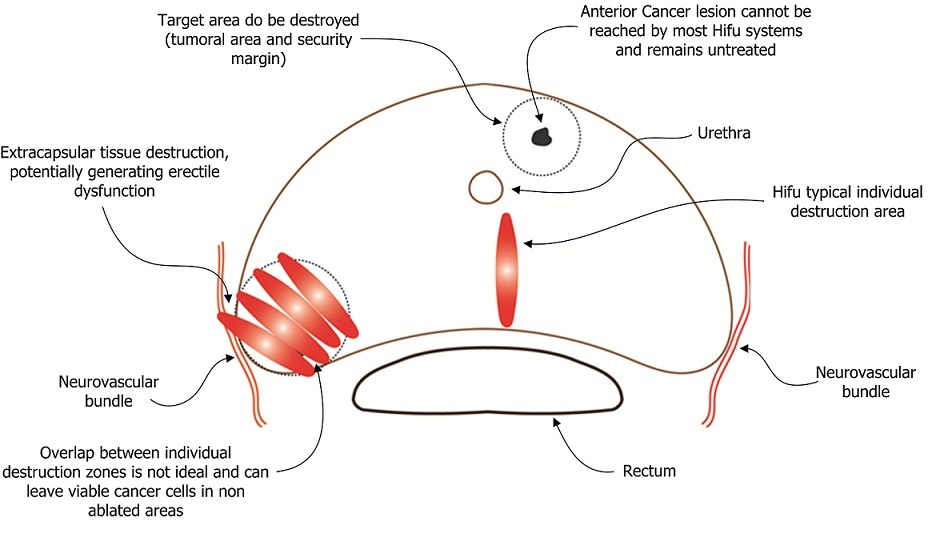Treating Prostate Cancer
The most common treatments for prostate cancer are Robotic Surgery and Radiotherapy:
- Robotic Surgery is an aggressive treatment where the prostate is surgically removed. Surgery often damages sensitive organs surrounding the prostate, like nerve bundles and the urethra, generating high rates of adverse side-effects such as Erectile Dysfunction and Urinary Incontinence.
- Radiotherapy is the treatment of tissue by ionizing radiation and several different modalities are commonly used in prostate cancer. A recent comprehensive US-based study has shown within two years of therapy Erectile Dysfunction rates up to 23.3% and Urinary Incontinence rates up to 41.7% (results of the publication are available upon request).
More recently and because of the devastating adverse side-effects of classic treatments a new treatment modality has arisen: Prostate Focal Therapy.
What is Focal Therapy?
- Focal Therapy is a general term for a variety of noninvasive techniques for destroying tumor cells inside the prostate while leaving the remaining gland intact and avoiding adverse side-effects associated with classic treatments.
- The main goal of Focal Therapy is eradicating tumors within the prostate and avoiding damage to sensitive surrounding tissues, thus preserving patients’ quality of life (Focal Therapy is not a standard of care and is still considered experimental).
- Focal Therapy can be a good option for younger patients, patients with less aggressive types of cancer, and those unable or unwilling to undergo surgery or radiotherapy (Focal Therapy is not for every patient and only a Urologist can determine if you are a good candidate).
Most Focal Therapy techniques are adaptations of older technologies historically used for the treatment of the whole prostate, such as Cryoablation and Hifu (High-Frequency Ultrasound).

Cryoablation is a treatment modality where tissue within the prostate is destroyed by cold basically generated by ice balls spreading out of a specific gas-fueled probe. Even if it’s effective in destroying cancer cells, the expansion of the ice balls is difficult to control, which results in surrounding tissue damage and high rates of adverse side-effects (Erectile Dysfunction rates as high as 100% according to some publications).
Cryoablation treatment lacks consistency and has a high risk of side effects.

High-Frequency Ultrasound (Hifu) is a treatment modality where high-frequency ultrasound waves are targeted to the prostate from a probe inserted in patients’ rectum. A limited amount of tissue can be targeted at a time that makes complete destruction of most tumors difficult to reach (partial tumor destruction). High side effects rates have been reported by the manufacturer (see table below).
Hifu ablation treatment often misses cancer cells and has a high risk of side effects.
| Adverse Event | Number of Subjects (%) |
|---|---|
| Erectile Dysfunction | 91 (67.4%) |
| Urinary Incontinence | 52 (38.5%) |
| Urinary Tract Infection | 46 (34.1%) |
| Hematuria | 44 (32.6%) |
| Bladder urgency | 39 (28.9%) |
| Perineal/penile/rectal/prostate pain | 37 (27.4%) |
| Urinary Obstruction | 33 (24.4%) |
| Slow stream | 33 (24.4%) |
| Bladder spasms | 31 (23.0%) |
| Dysuria | 31 (23.0%) |
| Urinary Retention not resolved by day 30 or onset >= 30 days | 28 (20.7%) |
| Stricture | 26 (19.3%) |
| Urinary frequency | 25 (18.5%) |
| Bladder Neck Contracture | 24 (17.8%) |
| Urethral sloughing | 17 (12.6%) |
| Urinary Retention Resolved by Day 30 | 12 (8.9%) |
| Bowel Injury | 4 (3.0%) |
| Epididymitis | 4 (3.0%) |
| Sepsis | 2 (1.5%) |
| * Anal tears ** Both causes of sepsis were not considered to be related to either the device or the procedure |
